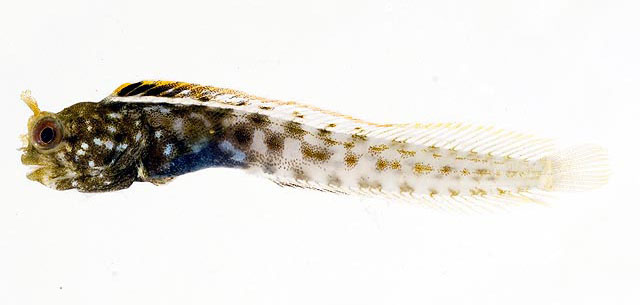| Chaenopsidae (Pike-, tube- and flagblennies) |
| 3.6 cm SL (male/unsexed) |
|
reef-associated; marine |
| Western Atlantic: off Belize, Honduras and Colombia (Ref. 26282). Also in Jamaica, Yucatan, Isla de Providencia (Ref. 26938). |
|
Anal spines: 2-2. Species distinguished by: total dorsal-fin elements usually 39 or more; dorsal fin consisting of spines and segmented rays; several spines present on posterior third of supraorbital flange; fleshy lateral margins of interorbital region without papillae; spiny processes on head poorly developed, when present consisting of a few knobby projections; supraorbital cirrus moderately to strongly branched, cranial spines not short and blunt; patch of cranial spines on nape ends anterior to supratemporal commissural pore; inner rim of posterior infraorbital bone smooth; two or more rows of teeth on each palatine bone; top of head often spiny; no large, eye-diameter sized dark blotch on side of head posterior to eye. Common amongst Chaenopsids: small elongate fishes; largest species about 12 cm SL, most under 5 cm SL. Head usually with cirri or fleshy flaps on anterior nostrils, eyes, and sometimes laterally on nape; gill membranes continuous with each other across posteroventral surface of head. Each jaw with canine-like or incisor-like teeth anteriorly; teeth usually also present on vomer and often on palatines (roof of mouth). Dorsal-fin spines flexible, usually outnumbering the segmented soft rays (numbering 7 to 37), spinous and segmented-rayed portions forming a single, continuous fin; 2 flexible spines in anal fin; pelvic fins inserted anterior to position of pectoral fins, with 1 spine not visible externally and only 2 or 3 segmented (soft) rays; all fin rays, including caudal-fin rays, unbranched (simple). Lateral line absent. Scales absent (Ref.52855). |
|
|
Least Concern (LC); Date assessed: 18 October 2007 Ref. (130435)
|
| harmless |
Source and more info: www.fishbase.org. For personal, classroom, and other internal use only. Not for publication.

